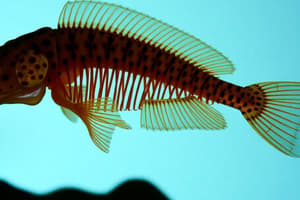Podcast
Questions and Answers
What is the classification for Kingdom Animalia?
What is the classification for Kingdom Animalia?
- Fungi
- Multicellular, eukaryotic, heterotrophic organisms (correct)
- Single-celled organisms
- Plants
What is a characteristic of the Phylum Chordate?
What is a characteristic of the Phylum Chordate?
They have three embryonic tissues and a notochord.
Mammals are known for laying eggs.
Mammals are known for laying eggs.
False (B)
What distinguishes members of the Order Artiodactyla?
What distinguishes members of the Order Artiodactyla?
The ______ is a family known for being herbivorous and having a three-chambered digestive tract.
The ______ is a family known for being herbivorous and having a three-chambered digestive tract.
What are the distinctive features of the Genus Camelus?
What are the distinctive features of the Genus Camelus?
Which species has one hump on its back?
Which species has one hump on its back?
Study Notes
Classification of Dromedary Camel
-
Animalia (Kingdom): Multicellular, eukaryotic, heterotrophic organisms. Majority exhibit motility during part of their life cycle, reproduce sexually, and possess nervous systems.
-
Chordate (Phylum): This phylum is the most recently evolved in the animal kingdom. Organisms in this group have three embryonic tissues, along with complete digestive, circulatory, respiratory, and nervous systems. They possess a notochord, a hollow dorsal nerve cord, and a post-anal tail at some stage in their development.
-
Mammalia (Class): Known for highly developed nervous systems, mammals typically give birth to live young instead of laying eggs. Embryos develop within the mother's body and are nourished through milk glands that provide essential nutrients for infants.
-
Artiodactyla (Order): Members of this order distribute their body weight evenly between the third and fourth toes instead of primarily relying on the third toe, as seen in odd-toed ungulates like horses.
-
Camelidae (Family): Characterized by large body frames, slender necks, and long legs, camelids are entirely herbivorous and possess a unique three-chambered digestive tract. Their legs connect to the body at the top of the thigh, which necessitates lying down by resting on their knees.
-
Camelus (Genus): This genus includes camels with distinct fatty humps on their backs. There are two species: the dromedary camel and the Bactrian camel (which has two humps), with the latter native to Central and East Asia. Both species are domesticated and serve valuable roles by providing milk, meat, and labor.
-
C. dromedaries (Species): The dromedary camel features a single hump on its back and thrives in arid environments such as deserts. It is predominantly domesticated and is easily recognized by its thick eyelashes and small, hairy ears.
Studying That Suits You
Use AI to generate personalized quizzes and flashcards to suit your learning preferences.
Description
Test your knowledge about the classification of the dromedary camel, focusing on the animal kingdom and phylum Chordate. This quiz will cover essential definitions and characteristics of these classifications. Perfect for students studying animal biology!




